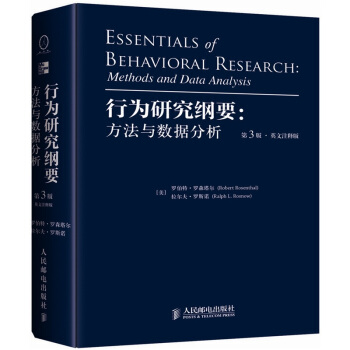

具体描述
内容简介
这是一本经典的高级研究方法教材。两位作者分别用几十年的时间从事心理学教学和研究工作,其研究重心又集中在心理学研究方法和数据分析方面。他们在这方面进行了深入钻研和分析,并结出了丰硕的成果,共同合作出版了多本关于研究方法和数据分析的著作。《行为研究纲要:方法与数据分析(英文注释版)(第3版)》这本著作的前半部分着重于研究方法的论述,涉及基础概念和基本伦理、因变量的操作和测量以及研究设计的逻辑;后半部分着重于描述高级统计过程,包括四个部分:数据分析基础、单因素设计、因素设计以及数据分析的其他问题。附录中还包括书中用到的公式、常用统计图表、术语及参考文献。
《行为研究纲要:方法与数据分析(英文注释版)(第3版)》是心理学、社会学、人类学、传播学、教育学、商学、统计学、市场营销学等多个学科领域的教师、学者和学生从事教学和研究工作所必备的一本工具书。
作者简介
Robert Rosenthal is Distinguished Professor at the University of California at Riverside and Edgar Pierce Professor of Psychology, Emeritus, Harvard University. His research has centered for some 50 years on the role of the self-fulfi lling prophecy in everyday life and in laboratory situations. Special interests include the effects of teachers’ expectations on students’performance, the effects of experimenters’expectations on the results of their research, and the effects of clinicians’expectations on their patients’mental and physical health. He also has strong interests in sources of artifact in behavioral research and in various quantitative procedures. In the realm of data analysis, his special interests are in experimental design and analysis, contrast analysis, and meta-analysis. His most recent books and articles are about these areas of data analysis and about the nature of nonverbal communication in teacher-student, doctorpatient, manager-employee, judge-jury, and psychotherapist-client interaction. He has been Co-Chair of the Task Force on Statistical Inference of the American Psychological Association and has served as Chair of the Research Committee of the Bayer Institute for Health Care Communication. He was a co-recipient of two behavioral science awards of the American Association for the Advancement of Science (1960,1993) and recipient of the James McKeen Cattell Award of the American Psychological Society, the Distinguished Scientist Award of the Society of Experimental Social Psychology, the Samuel J. Messick Distinguished Scientifi c Contributions Award of the APA’s Division 5—Evaluation, Measurement, and Statistics, and the APA’s Distinguished Scientifi c Award for Applications of Psychology.
Ralph L. Rosnow is Thaddeus Bolton Professor Emeritus at Temple University, where he taught for 34 years and directed the graduate program in social and organizational psychology. He has also taught research methods at Boston University and Harvard University and does consulting on research and data analysis. The overarching theme of his scholarly work concerns how people make sense of, and impose meaning on,their experiential world, called the “will to meaning” by Viktor Frankl. Rosnow has explored aspects of this construct in research and theory within the framework of contextualism, the psychology of rumor and gossip, attitude and social cognition, the structure of interpersonal acumen, artifacts and ethical dilemmas in human research,and the statistical justifi cation of scientifi c conclusions. He has authored and coauthored many articles and books on these topics and, with Mimi Rosnow, coauthored Writing Papers in Psychology, a popular writing manual now in its seventh edition (published by Thomson Wadsworth, 2006). He has served on the editorial boards of journals and encyclopedias, was coeditor (with R. E. Lana) of the Reconstruction of Society Series published by Oxford University Press, and chaired the APA’s Committee on Standards in Research. He is a fellow of the American Association for the Advancement of Science, the APA, and the Association for Psychological Science, received the Society of General Psychology’s George A. Miller Award, and was recently honored with a Festschrift book edited by D. A. Hantula, Advances in Social and Organizational Psychology
Rosenthal and Rosnow have also collaborated on other books on research methods and data analysis, including Artifact in Behavioral Research (Academic Press, 1969);The Volunteer Subject (Wiley, 1975); Primer of Methods for the Behavioral Sciences(Wiley, 1975); Understanding Behavioral Science: Research Methods for Research Consumers (McGraw-Hill, 1984); Contrast Analysis: Focused Comparisons in the Analysis of Variance (Cambridge University Press, 1985); People Studying People: Artifacts and Ethics in Behavioral Research (W. H. Freeman, 1997); (with D. B. Rubin)Contrasts and Effect Sizes in Behavioral Research: A Correlational Approach (Cambridge University Press, 2000); and Beginning Behavioral Research: A Conceptual
Primer (6 th ed., Pearson/PrenticeHall, 2008).
目录
第一编 概念与伦理基础第1章 行为研究的精神
第2章 探索与辩护的环境
第3章 伦理问题、道德两难问题与指导方针
第二编 因变量的可操作化和可测量化
第4章 测量信度和效度
第5章 观察、判断和复合变量
第6章 问卷法、访谈法和日志法
第三编 研究设计的逻辑
第7章 随机控制的实验和因果推论
第8章 非随机化研究与函数关系
第9章 随机与非随机抽取样本
第四编 数据分析的基本原理
第10章 描述、展示以及探究数据
第11章 相关关系
第12章 统计检验力与效应值
第五编 单因素设计
第13章 用t 检验比较均值
第14章 方差分析与F 检验
第15章 单因素对比分析
第六编 因素设计
第16章 多因素方差分析
第17章 方差分析中的交互作用
第18章 重复测量方差分析
第七编 数据分析的补充问题
第19章 显著性检验和列联表分析
第20章 多元数据分析
第21章 元分析:研究结果的比较和综合
第八编 附录
详细目录
PART I CONCEPTUAL AND ETHICAL FOUNDATIONS
Chapter The Spirit of Behavioral Research
Science and the Search for Knowledge
What Do Behavioral Researchers Really Know?
Social Constructionism
Contextualism/Perspectivism
Evolutionary Epistemology
Peirce’s Four Ways of Knowing
Rhetoric, Perceptibility, and Aesthetics
Limitations of the Four Supports of Conviction
Behavioral Research Defi ned
Three Broad Research Orientations
The Descriptive Research Orientation
The Relational Research Orientation
The Experimental Research Orientation
Empirical Principles as Probabilistic Assertions
Orienting Habits of Good Scientifi c Practice
Chapter Contexts of Discovery and Justifi cation
Inspiration and Explanation
Theories and Hypotheses
Sources of Inspiration and Insight
Serendipity in Behavioral Research
Molding Ideas Into Working Hypotheses
Positivism, Falsifi cationism, and Conventionalism
Type I and Type II Decision Errors
Statistical Signifi cance and the Effect Size
Two Families of Effect Sizes
Interval Estimates Around Effect Sizes
Summing Up
Chapter Ethical Considerations, Dilemmas,and Guidelines
Puzzles and Problems
A Delicate Balancing Act
Historical Context of the American Psychological Association Code
The Belmont Report, Federal Regulations, and the Institutional
Review Board
Principle I: Respect for Persons and Their Autonomy
Principle II: Benefi cence and Nonmalefi cence
Principle III: Justice
Principle IV: Trust
Principle V: Fidelity and Scientifi c Integrity
Costs, Utilities, and Institutional Review Boards
Scientifi c and Societal Responsibilities
PART II OPERATIONALIZATION AND MEASUREMENT OF DEPENDENT VARIABLES
Chapter Reliability and Validity of Measurements
Random and Systematic Error
Assessing Stability and Equivalence
Internal-Consistency Reliability and Spearman-Brown
KR20 and Cronbach’s Alpha
Effective Reliability of Judges
Effective Cost of Judges
Effective Cost of Items
Interrater Agreement and Reliability
Cohen’s Kappa
Replication in Research
Validity Criteria in Assessment
Convergent and Discriminant Validity
Test Validity, Practical Utility, and the Taylor-Russell Tables
Relationship of Validity to Reliability
Chapter Observations, Judgments, and Composite Variables
Observing, Classifying, and Evaluating
Observing While Participating
Maximizing Credibility and Serendipity
Organizing and Sense-Making in Ethnographic Research
Interpreter and Observer Biases
Unobtrusive Observations and Nonreactive Measurements
Selecting the Most Appropriate Judges
Choosing the Number of Response Alternatives
Effects of Guessing and Omissions on Accuracy
Intrinsic Factors and the Level of Accuracy
Applications of Categorical Judgments
Category Scales and Rating Scales
Numerical, Graphic, and Magnitude Ratings
Rating Biases and Their Control
Bipolar Versus Unipolar Scales
Forming Composite Variables
Forming Multiple Composites
Quantifying the Clarity of Composites
Chapter Questionnaires, Interviews, and Diaries
Concerns About Self-Report Data
Open-Ended Versus Structured Items
Critical Incident Technique
Stages in Developing Interview Protocols
Research Interviews by Telephone
Developing Research Questionnaires
Defensiveness, Inconsistency, and Yea-Saying
Cross-Cultural Questionnaire and Interview Research
One-Dimensional and Multidimensional Attitude Scales
Semantic Differentials for Attitudinal Meaning
Q-Sorts for Subjectivity Ratings
Likert Method of Item Analysis
Thurstone Equal-Appearing Intervals Method
Memory and the Use of Self-Recorded Diaries
PART III THE LOGIC OF RESEARCH DESIGNS
Chapter Randomized Controlled Experiments and Causal Inference
Experimentation in Science
Randomized Experimental Designs
Characteristics of Randomization
The Philosophical Puzzle of Causality
Contiguity, Priority, and Constant Conjunction
Four Types of Experimental Control
Mill’s Methods of Agreement and Difference
Between-Group Designs and Mill’s Joint Method
Independent, Dependent, and Moderator Variables
Solomon’s Extended Control Group Design
Threats to Internal Validity
Threats to External Validity
Statistical Conclusion and Construct Validity
Subject and Experimenter Artifacts
Demand Characteristics and Their Control
Interactional Experimenter Effects
Experimenter Expectancy Effects and
Their Control
Concluding Commentary
Chapter Nonrandomized Research and Functional Relationships
Nonrandomized and Quasi-Experimental Studies
Nonequivalent Groups and Historical Controls
Interrupted Time Series and the Autoregressive Integrated Moving Average
Single-Case Experimental Designs
Cross-Lagged Correlational Designs
Invisible Variables and the Mediation Problem
Path Analysis and Causal Inference
The Cohort in Longitudinal Research
Different Forms of Cohort Studies
Subclassifi cation on Propensity Scores
Multiple Confounding Covariates
Chapter Randomly and Nonrandomly Selected Sampling Units
Sampling a Small Part of the Whole
Bias and Instability in Surveys
Simple Random-Sampling Plans
Improving Accuracy in Random Sampling
Confi dence Intervals for Population Estimates
Speaking of Confi dence Intervals
Other Selection Procedures
Nonresponse Bias and Its Control
Studying the Volunteer Subject
Characteristics of the Volunteer Subject
Implications for the Interpretation of
Research Findings
Situational Correlates and the Reduction of
Volunteer Bias
The Problem of Missing Data
Procedures for Dealing With Missing Data
PART IV FUNDAMENTALS OF DATA ANALYSIS
Chapter Describing, Displaying, and Exploring Data
Descriptions of Sampling Units
Frequency Diagrams and Stem-and-Leaf Displays
Box Plots
Comparing Distributions Back to Back
Measures of Central Tendency
Measures of Spread
The Normal Distribution
Standard Scores
Data Not Distributed Normally
Precision of Estimating Population Means
Defi ning Outliers
Coping With Outliers
Exploring the Data
Chapter Correlation
Pearson r
Proportion of Variance Interpretation of Correlation
Binomial Effect-Size Display
Confi dence Intervals for Effect-Size Correlations
Small Correlations, But Important Effects
Counternull Values of Effect Sizes
Spearman Rank Correlation
Ranks as a Transformation
Observations of Disproportionate Infl uence
Point-Biserial Correlation
Exact Tests for Rho
Phi Coeffi cient
Curvilinear (Quadratic) Correlation
Five Product-Moment Correlations
Comparing Correlations
Considering Third Variables
Effects of Variability on Correlations
Chapter Statistical Power and Effect Size Revisited
Why Assess Statistical Power?
The Neglect of Statistical Power
The requivalent Statistic
Cohen’s Multipurpose Power Tables
The t Test for Comparing Two Means
The Signifi cance of a Product-Moment r
Differences Between Correlation Coeffi cients
The Test That a Proportion is .50
The Difference Between Proportions
The Focused Chi-Square Test
F Tests for Focused Comparisons
Additional Strategies for Improving Power
PART V ONE-WAY DESIGNS
Chapter Comparing Means by Standard t Tests
Gosset and the t Test
Two Components of t Tests
Maximizing t
Effect Sizes and Adjustments for Unequal Sample Sizes
Interpreting the Independent Sample t
Computing the Independent Sample t
Reporting the Results
t Tests for Nonindependent Samples
Effect Size and Study Size Components of Nonindependent Sample t
Assumptions Underlying t Tests
Nonparametric Procedures
The Bootstrap, the Jackknife, and Permutation Tests
Chapter Analysis of Variance and the F Test
The F Test and the t Test
The Analysis of “Variances”
Illustration of an Omnibus F
Dividing Up the Total Variance
ANOVA Summary Tables
Distributions of F
After the Omnibus F
Protecting Against “Too Many t Tests”
Bonferroni Procedures
Bonferroni Tolerance Value
Comparing Two Independent Variabilities
Illustration Using Transformations
Comparing Two Correlated Variabilities
Comparing Three or More Independent Variabilities
Comparing Three or More Correlated Variabilities
Summary of Procedures for Comparing Variabilities
Chapter One-Way Contrast Analyses
Focusing Our Questions and Statistical Tests
Contrast F Tests on Original Data
Contrast t Tests on Original Data Carving Contrasts Out of Published Data
Orthogonal Contrasts
Nonorthogonal Contrasts
Effect Size Indices for Contrasts
The BESD and the Binomial Effect-Size Correlation
Overview of the Four Effect-Size Indices
Comparing Competing Contrasts
Combining Competing Contrasts
Optimal Design and the Allocation of Sample Sizes
PART VI FACTORIAL DESIGNS
Chapter Factorial Analysis of Variance
Confronting Persistent Misunderstandings
An Economy of Design
Effects and the Structure of ANOVA
Individual Differences as Error
The Table of Variance
Testing the Grand Mean by t and F
Unweighted Means Analysis for Equal or Unequal Sample Sizes
Effects on F of Unequal Sample Sizes
Unequal Sample Sizes and Contrasts
Transcending Factorial Structure Using Contrasts
Higher Order Factorial Designs
Blocking and the Increase of Power
Blocking and the Analysis of Covariance
Transforming Data to Remove Interactions
Chapter Interaction Effects in Analysis of Variance
The Interpretation of Interaction
Crossed and Uncrossed Combinations of Group Means
Illustration of Mean Polishing
Constructing Tables of Predicted Means
Studying Interactions in Two-Way Tables
Three-Way Factorial Designs
Defi ning Three-Way Interactions
Further Notes on Interpretation
Simplifying Complex Tables of Residuals
Illustration of a Five-Way Interaction
A Note on Complexity
Chapter Repeated Measures in Analysis of Variance
Use of Repeated Observations
Basic Computations
Fixed and Random Effects Error Terms in the Four Basic Combinations
Latin Squares and Counterbalancing
Analysis of Latin Squares
Some Latin Squares May Be Better Than Others
Other Counterbalancing Designs
Three or More Factors
Two Within-Subjects Factors
Aggregating Error Terms
Three Within-Subjects Factors
Fixed or Random Factors
Did Repeated Measures Help?
The Intraclass r Revisited
Composite Variables and Additional Assumptions
Contrasts in Repeated Measures
Hierarchically Nested Designs
The Choice of Error Terms
PART VII ADDITIONAL TOPICS IN DATA ANALYSIS
Chapter Significance Testing and Association in Tables of Counts
Table Analysis and Chi-Square
The - df Chi-Square Test
Larger Tables of Counts
Distributions of Chi-Square
Procedures for Larger Contingency Tables
Subdividing Tables to Test Specifi c Hypotheses
Fisher Exact Probability Test
Strengthening the Fisher Exact Test
Adjustments for in _ Tables
Complete Partitioning of Larger Tables
The Corner-Cells Test Subtable
Contrasts in Proportions
Alternative Analyses for Smaller Sample Studies
Standardizing Row and Column Totals
Odds Ratio, Relative Risk, Risk Difference, and Phi
One-Sample Tables of Counts
Multiple-Choice-Type Data and the Proportion Index
Chapter Multivariate Data Analysis
Background
Redescribing Relationships Within Sets of Variables
Cluster Analysis for Redescription
Principal Components Analysis for Redescription
ros31960_ Improving Interpretation by Rotation
Psychometric Applications of Principal Components Analysis
Alternatives for the Redescription of Variables
Multidimensional Scaling Illustration
Relationships Among Sets of Variables
Chapter Meta-Analysis: Comparing and Combining Research Results
Statistical Analysis of Statistical Analyses
Criticisms of Meta-Analysis
Interpreting Two or More Studies
Comparing Two Signifi cance Levels
Comparing Two Effect-Size Correlations
Combining Two Signifi cance Levels
Combining Two Effect-Size Correlations
Overall Comparisons of Three or More Studies
Focused Comparisons of Three or More Studies
Combining Three or More p Levels
Combining Three or More Effect-Size Correlations
Results That Are Not Independent
The File Drawer Problem
An Eye to Variability
PART VIII APPENDIXES
A List of Numbered Equations
B Statistical Tables
Glossary
References
Subject Index
Name Index
前言/序言
用户评价
这本书绝对是为那些真心想深入了解行为研究领域的研究者准备的。我花了将近一周的时间才初步浏览完,感觉信息量巨大,但每一页都塞满了宝贵的见解。作者在介绍研究方法时,并没有停留在理论层面,而是花了大量篇幅去剖析每种方法的优劣,适用场景,以及在实际操作中可能遇到的陷阱。尤其是数据分析部分,感觉作者就像一位耐心的导师,一步步地引导读者理解统计原理,并详细解释了如何使用不同的统计软件来处理和解释数据。书中的案例分析非常有说服力,都是来自真实的研究,这让抽象的概念变得生动具体,也更容易让人理解理论如何转化为实践。虽然我是初次接触行为研究,但这本书的条理性让我感觉自己像是在一个精心设计的迷宫里探索,虽然有时会感到挑战,但总能找到前进的方向。而且,英文注释的存在,对于理解一些专业术语的细微差别非常有帮助,有时候翻译过来可能会丢失原有的含义,而这里的注释则避免了这种情况,让我能够更准确地把握作者的意图。我特别欣赏作者在强调严谨性的同时,也鼓励创新和批判性思维,这让我感觉这本书不仅仅是传授知识,更是在培养研究者的独立思考能力。
评分这本书绝对是我迄今为止读过的关于行为研究最全面、最实用的指南。作者的写作风格非常吸引人,他能够将枯燥的学术内容讲得生动有趣,而且逻辑清晰,条理分明。我之前对某些研究方法一直有些模糊的概念,但通过这本书的讲解,我终于能够豁然开朗。作者在介绍每种方法时,都详细阐述了其背后的理论基础,并且结合了大量真实的案例,让我能够深刻理解这些方法是如何在实际研究中发挥作用的。数据分析部分更是让我惊喜连连。作者用非常易懂的语言,将复杂的统计概念娓娓道来,并且提供了详细的操作步骤和图示,让我这个之前对数据分析一窍不通的人,也能够轻松上手。书中的英文注释,对我理解那些晦涩难懂的专业术语提供了极大的帮助,让我能够更准确地把握作者想要表达的意思。我特别欣赏作者在强调严谨性的同时,也鼓励创新和批判性思维,这让我觉得这本书不仅仅是一本技术手册,更是一种研究思想的启迪。
评分我是一名在读的研究生,在选择研究方法和进行数据分析时,常常感到困惑。这本书为我提供了一个非常清晰且全面的框架。作者在方法论部分,对每种研究设计的优缺点都做了详尽的分析,并且提供了丰富的实例,让我能够根据自己的研究问题,选择最适合的方法。最令我赞叹的是,书中在数据分析部分,不仅仅是介绍了各种统计方法,更是深入探讨了每种方法的原理和适用条件,以及如何解读分析结果。作者还特别强调了批判性思考在数据分析中的重要性,这让我受益匪浅。书中的英文注释,对我理解一些复杂的统计概念和研究术语起到了至关重要的作用,让我能够更准确地把握作者的意图。我尤其喜欢作者在书中穿插的一些小技巧和建议,它们都是在实际研究中非常实用的经验总结。总而言之,这本书为我构建了一个坚实的研究基础,让我能够更加自信地进行我的学术研究。
评分如果你正计划开展一项行为研究,又对数据分析感到头疼,那么这本书绝对是你的救星。我之前一直觉得行为研究离我比较遥远,直到我翻开这本书,才发现原来它并没有想象中那么难以接近。作者的写作风格非常独特,他用一种非常亲切、甚至可以说是幽默的方式来讲解复杂的概念。举个例子,在讲到“观察法”时,他会用生动的比喻来形容不同类型的观察,让我一下子就明白了其中的区别。而数据分析的部分,我之前一直对统计软件感到畏惧,但这本书的指导让我觉得没那么可怕了。作者详细列出了每一步的操作,并配有清晰的图示,我跟着书中的例子,几乎是零障碍地完成了第一次数据分析。最让我惊喜的是,这本书并没有局限于介绍“怎么做”,而是深入探讨了“为什么这么做”的道理。它会告诉你,在选择某种研究方法时,应该考虑哪些因素,不同的数据分析方法会对研究结果产生怎样的影响,以及如何避免常见的研究偏见。这种深度的讲解,让我感觉自己不仅仅是在学习一种技能,更是在理解一种研究的哲学。而且,书中穿插的英文注释,简直是神来之笔,对于我这种英文基础不太好的人来说,简直是福音,让我能够轻松理解那些让我困惑的专业词汇,而且还能学到地道的表达方式。
评分这本书的价值,远远超出了一本教科书的范畴。我是一名刚刚起步的研究者,在开始我的第一个项目时,简直是摸着石头过河。这本书就像一位经验丰富的老前辈,在我迷茫的时候,给我指明了方向。作者在介绍各种研究方法时,不仅仅是罗列它们的定义和特点,而是花了大量的篇幅去分析它们在实际研究中的应用,以及可能遇到的挑战。他会告诉你,为什么在某种情况下,某种方法比另一种更有效,以及如何巧妙地规避潜在的偏差。数据分析的部分更是让我眼前一亮。我之前对统计学一直存在一种恐惧感,但这本书用非常直观的方式,把复杂的统计概念分解开来,并且结合了实际的数据案例,让我能够清晰地理解如何运用各种统计工具来分析我的数据。书中的英文注释,对我来说简直是宝藏。它们不仅解释了专业术语,还提供了一些深入的背景信息,让我能够从更广阔的视角来理解这些概念。我特别喜欢作者在章节末尾提出的思考题,它们能够引导我反思所学的内容,并将其与自己的研究联系起来。总的来说,这本书不仅仅是一本知识的集合,更是一种研究思维的启蒙,让我对行为研究有了更深刻的理解和更坚定的信心。
评分第12章 统计检验力与效应值
评分这是一本经典的高级研究方法教材。两位作者分别用几十年的时间从事心理学教学和研究工作,其研究重心又集中在心理学研究方法和数据分析方面。他们在这方面进行了深入钻研和分析,并结出了丰硕的成果,共同合作出版了多本关于研究方法和数据分析的著作。
评分nice
评分外皮破损不堪,类似脚印的脏印
评分外皮破损不堪,类似脚印的脏印
评分第19章 显著性检验和列联表分析
评分第四编 数据分析的基本原理
评分一般要读到研究生水平才能看得懂
评分第2章 探索与辩护的环境
相关图书
本站所有内容均为互联网搜索引擎提供的公开搜索信息,本站不存储任何数据与内容,任何内容与数据均与本站无关,如有需要请联系相关搜索引擎包括但不限于百度,google,bing,sogou 等
© 2025 book.coffeedeals.club All Rights Reserved. 静流书站 版权所有
















![左氏会笺(套装共5册)/[日] 竹添光鸿 pdf epub mobi 电子书 下载](https://pic.windowsfront.com/10990086686/5b287030N9ea77cef.jpg)



